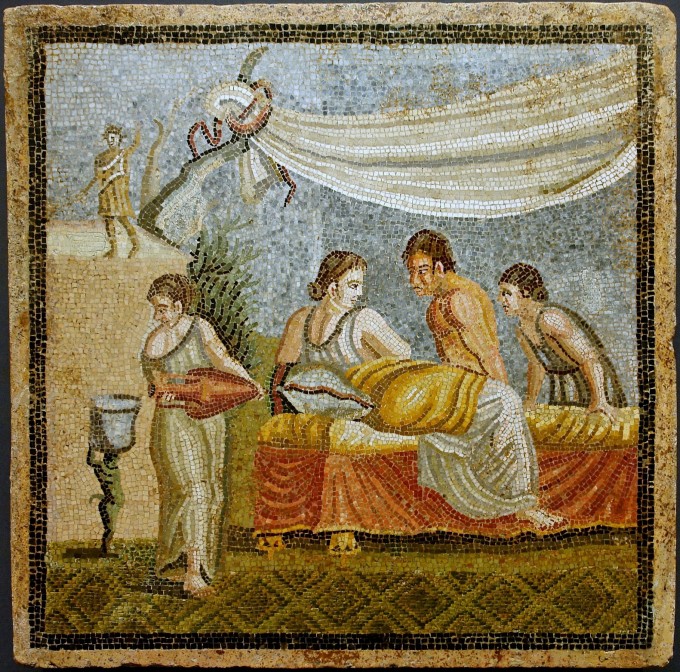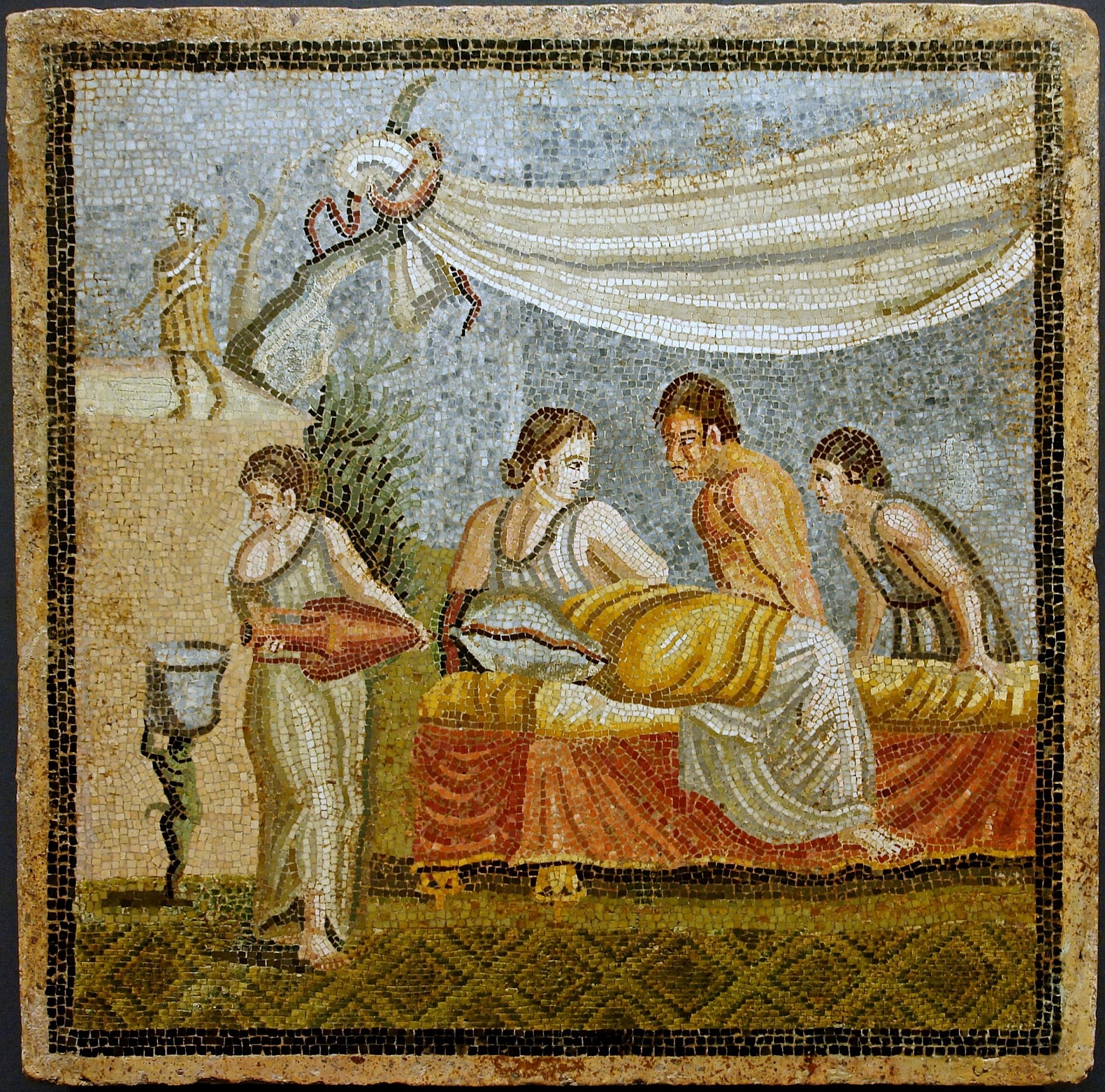Putting the Bride to Bed
By Susan Treggiari
Echos du Monde Classique/Classical Views, Vol.38, n.s. 13 (1994)

Introduction: The procreation of children was acknowledged as the purpose of a Roman legal marriage. So it is not surprising that the climax of the wedding was the moment when the bride and bridegroom went to bed together. The ceremonial surrounding this part of the festivities deserves perhaps more attention than it has recently been given by scholars, who tend to desert the bride at the moment when she is lifted over the threshold of the bridegroom’s house at the end of the noisy procession through the streets which formed such a dramatic rite de passage. Here I set out the evidence for Roman customs and rituals in bringing the couple into the bedroom and what was thought to be the emotional content for them of the semi-public ritual and of what happened when their supporters finally withdrew and left them together.
The evidence on putting lie bride to bed, collocare, is scattered from OlC early second century BC until the fifth century AD. ‘Contamination’ by Greek literary models and customs is likely, but a consistent Latin literary picture emerges, with very little change over time. Reconstruction of custom depends heavily on imaginative literature such as drama or mythological epic and on sophisticated poems in honour of upper-class couples. Much the same is true for sixteenth and seventeenth-century England. Clearly such sources will not give a straight realistic account. Poems, like the funerary reliefs, describe deities as present; they exaggerate the beauty of the bride, the super-human qualities of the bridegroom and the beauty and richness of their surroundings. But the actions and rituals overlaid by these ornaments can be separated out.
It is undeniable that poets often imitated other poets rather than observing the life around them, but I find it hard to accept that Claudian would go on mentioning customs known to Catullus and Terence if they had in fact become obsolete. Here I shall place firmer reliance on more prosaic (though often still rhetorical) accounts. Prose writers often allude to wedding rituals merely in passing, taking them for granted, as Cicero does, though to dramatic effect, in the Pro Cluentio (14-15). There is no reason to suppose that Gregory of Tours (Historia Francorum 1.47) would state incidentally that it was customary (at least in Gaul) to bring the couple to the bedchamber if it was not so.


 Rather, bedding the couple was commonly the culmination of the wedding festivities in Graeco-Roman culture over centuries. The rite reflected the universal purpose of marriage. Since it involved no extra expense it could have been practised by the poorest, though we have no direct evidence. The accompanying rituals, such as the participation of the pronuba, belong to the ideal portrayal of a wedding made canonical in literary and sculptural representations. Actual weddings might depart from these self-perpetuating norms according to taste and circumstances. English examples show that customs can be artificially perpetuated by fashion-setters, kept up in certain backward areas, elaborated or modified over time and in different social and geographical milieux. The impact of court weddings recorded in literature (Roman aristocratic and later imperial epithalamia, English masques and memoirs) may be considerable, though they cannot compare with the international influence of the televised weddings of the twentieth century in setting a pattern. We need to be alert to the danger of mistaking norm for practice, the ideal for the real. I am chiefly concerned with identifying what our sources assume to be the norms of Roman society — or a norm recognisable to the literate classes of the latinised West.
Rather, bedding the couple was commonly the culmination of the wedding festivities in Graeco-Roman culture over centuries. The rite reflected the universal purpose of marriage. Since it involved no extra expense it could have been practised by the poorest, though we have no direct evidence. The accompanying rituals, such as the participation of the pronuba, belong to the ideal portrayal of a wedding made canonical in literary and sculptural representations. Actual weddings might depart from these self-perpetuating norms according to taste and circumstances. English examples show that customs can be artificially perpetuated by fashion-setters, kept up in certain backward areas, elaborated or modified over time and in different social and geographical milieux. The impact of court weddings recorded in literature (Roman aristocratic and later imperial epithalamia, English masques and memoirs) may be considerable, though they cannot compare with the international influence of the televised weddings of the twentieth century in setting a pattern. We need to be alert to the danger of mistaking norm for practice, the ideal for the real. I am chiefly concerned with identifying what our sources assume to be the norms of Roman society — or a norm recognisable to the literate classes of the latinised West.
Sponsored Content


Putting the Bride to Bed
By Susan Treggiari
Echos du Monde Classique/Classical Views, Vol.38, n.s. 13 (1994)
Introduction: The procreation of children was acknowledged as the purpose of a Roman legal marriage. So it is not surprising that the climax of the wedding was the moment when the bride and bridegroom went to bed together. The ceremonial surrounding this part of the festivities deserves perhaps more attention than it has recently been given by scholars, who tend to desert the bride at the moment when she is lifted over the threshold of the bridegroom’s house at the end of the noisy procession through the streets which formed such a dramatic rite de passage. Here I set out the evidence for Roman customs and rituals in bringing the couple into the bedroom and what was thought to be the emotional content for them of the semi-public ritual and of what happened when their supporters finally withdrew and left them together.
The evidence on putting lie bride to bed, collocare, is scattered from OlC early second century BC until the fifth century AD. ‘Contamination’ by Greek literary models and customs is likely, but a consistent Latin literary picture emerges, with very little change over time. Reconstruction of custom depends heavily on imaginative literature such as drama or mythological epic and on sophisticated poems in honour of upper-class couples. Much the same is true for sixteenth and seventeenth-century England. Clearly such sources will not give a straight realistic account. Poems, like the funerary reliefs, describe deities as present; they exaggerate the beauty of the bride, the super-human qualities of the bridegroom and the beauty and richness of their surroundings. But the actions and rituals overlaid by these ornaments can be separated out.
It is undeniable that poets often imitated other poets rather than observing the life around them, but I find it hard to accept that Claudian would go on mentioning customs known to Catullus and Terence if they had in fact become obsolete. Here I shall place firmer reliance on more prosaic (though often still rhetorical) accounts. Prose writers often allude to wedding rituals merely in passing, taking them for granted, as Cicero does, though to dramatic effect, in the Pro Cluentio (14-15). There is no reason to suppose that Gregory of Tours (Historia Francorum 1.47) would state incidentally that it was customary (at least in Gaul) to bring the couple to the bedchamber if it was not so.
Click here to read this article from Academia.edu
Sponsored Content